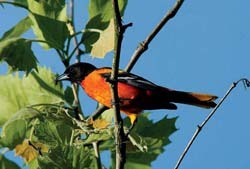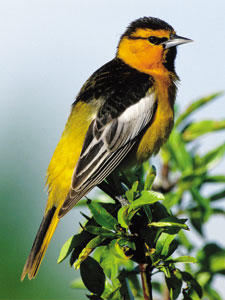


Fun Facts About Orioles
- Orioles are insect and fruit eaters. They usually stay hidden in the trees eating and singing their beautiful whistling notes. They can be drawn down from their perches with foods like orange slices, grape jelly, mealworms and nectar feeders.
- When not feeding on nectar, orioles seek out caterpillars, fruits, insects, and spiders.
- Unlike many insect eating birds, Baltimore Orioles will eat spiny or hairy caterpillars, including such pest species as fall webworms, tent caterpillars, and gypsy moths.
- Bullock’s Orioles may feed almost entirely on grasshoppers when they are plentiful, one bird was found to have feasted on 45 of them in one day.
While in their tropical winter habitats, Baltimore and Bullock’s Orioles feed on nectar from numerous flowering trees, which explains their attraction to nectar feeders upon their spring-time return to North America.
- While in their tropical winter habitat, the Baltimore and Bullock’s Oriole play an important role in pollinating several tree species as they transfer pollen from tree to tree while eating nectar from their flowers.
- Most male Baltimore Oriole songs vary enough from one another as to be unique to each individual. It is believed females can identify and locate their mate by its distinct song.
- The Oriole nest is an engineering masterpiece. They weave a hanging-basket nest with plant fibers, grasses, vine and tree bark and sometimes string or yarn placed out on the small twigs of a branch 6-45 feet in the air. This keeps them safe from most predators.
- It takes as many as 12 days for an Oriole to weave its nest. One Baltimore Oriole was observed spending 40 hours building a nest with about 10,000 stitches and the tying of thousands of knots, all with its beak.
- The female Baltimore Oriole builds her nest with little or no help from its mate. Only the female incubates and broods, both feed the young.
- The female Bullock’s Oriole is the primary nest weaver, but she may get some help from her mate in both the weaving and collection of nest material. Only the female incubates and broods, both feed the young.
- While modern day Oriole nests are made primarily of plant fibers, Oriole nests collected in the late 1800s, before the age of the automobile, were made almost exclusively of horsehair.
- Orioles will lay 4-5 eggs anywhere from April to June. The young will fledge as late as 30 days from egg laying.
- Orioles are found across North America in the summer. Some species winter in the tropics and others in Mexico.
- Most Baltimore Orioles spend their winters in southern Mexico, Central America and the tropics, but some will stay in the southern states of the U.S., with a few reports as far north as New England.
- Most Bullock’s Orioles spend their winters in central and southern Mexico, with a few staying along the coast of southern California.
- Both the Bullock’s and Baltimore Orioles start their southerly migration as early as July, with August being the prime migration month.
- Bullock’s and Baltimore Orioles migrate at night and are known to be victims of collisions with buildings and communication towers.
- The Baltimore Oriole was named in the early 1600s for George Calvert, Baron of Baltimore, whose livery stable was painted bright yellow and black.
- The Oriole is the state bird of Maryland.
- The Bullock’s Oriole was named in honor of William Bullock and his son, also named William, for their ornithological work in Mexico in the early 1800s.
- The Baltimore Oriole is a common inhabitant of suburban landscapes due to its preference for open settings that are bordered with mature trees.
- The Baltimore Oriole, found in the east, and the western Bullock’s Oriole were once considered to be the same species under the name Northern Oriole. While they do inter-breed in areas where their ranges overlap, genetic studies have shown them to be two distinct species.
- Orioles are a member of Icteridae family, meaning that their closest bird relatives include meadowlarks, blackbirds, bobolinks and grackles.
- The oriole gets its name from the Latin aureolus, which means golden.
- In areas with high quality habitat, Orchard Orioles may nest in close proximity to each other; a single tree may even contain several nests.
- The Scott's Oriole, a summer resident of the Southwest U.S., weaves its nest out of fibers from yucca plant leaves.
- Orioles appear to be sensitive to the spraying of pesticides, with birds succumbing directly from the poison and from the loss of their insect food sources.
- The oldest banded Baltimore Oriole recaptured in the wild had lived 11 years and 7 months.
- The oldest banded Orchard Oriole ever recaptured in the wild had lived 9 years and 3 months.
- The oldest banded Bullock’s Oriole ever recaptured in the wild had lived 6 years and 1 month.

